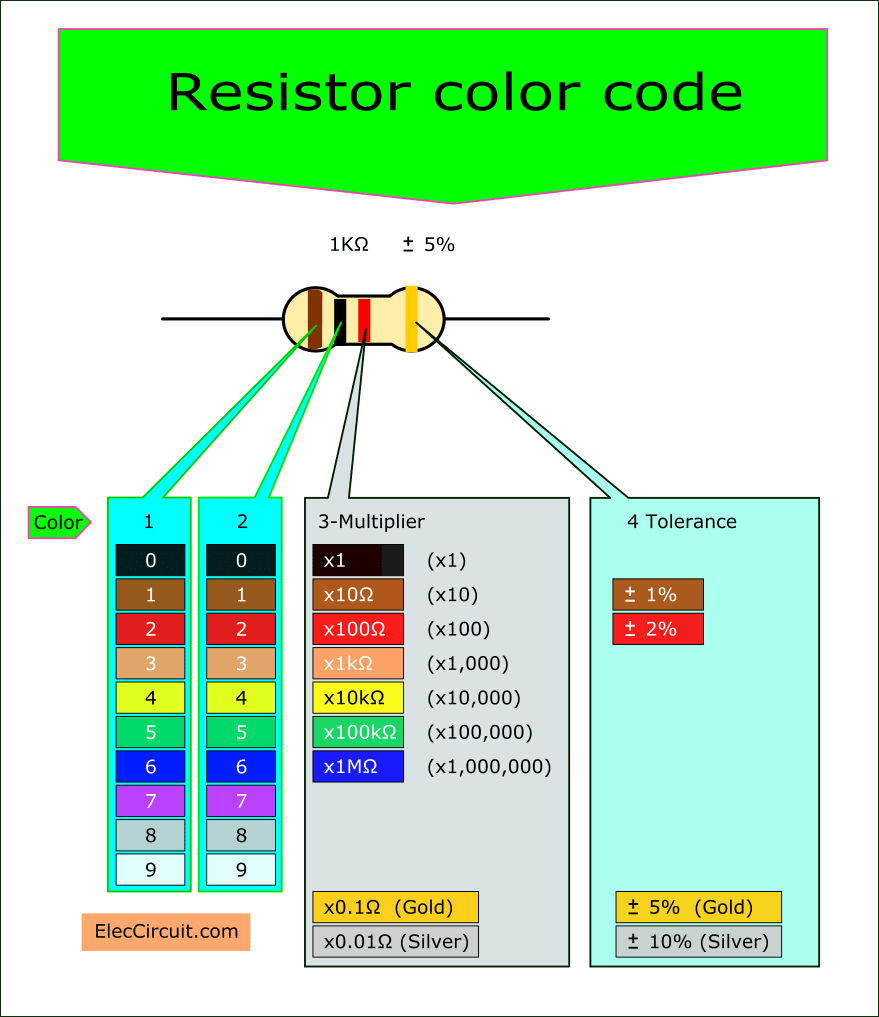
The first two bands represent the significant digits, the 3rd is the multiplication factor, the 4th is the tolerance, and the 5th is the temperature coefficient (ppm/˚C). 5 band resistor with a 4th band of gold or silver: Five band resistors with a fourth band of gold or silver form an exception and are used on specialized and older resistors.Using the resistor package allows the same automated pick-and-place machines to place the components on a circuit board. Principally, it is used as a wire link that functions to connect traces on a printed circuit board (PCB).

#Resistor color code how to#
The chart below shows how to determine the resistance and tolerance for resistors. The values of components in surface mount packages are marked with printed alphanumeric codes instead of a color code. Advances in printing technology have now made printed numbers more practical on small components. Overheating of a component or dirt accumulation may make it impossible to distinguish brown from red or orange. However, there were drawbacks, especially for color blind people.
#Resistor color code code#
In addition to the color code, these standards define a letter and digit code named RKM code for resistors and capacitors.Ĭolor bands were used because they were easily and cheaply printed on tiny components. The current international standard defining marking codes for resistors and capacitors in IEC 60062:2016 and EN 60062:2016. Originally only meant to be used for fixed resistors, the color code was extended to also cover capacitors with IEC 62:1968. In 1952, it was standardized in IEC 62:1952 by IEC and since 1963 also published as EIA RS-279. Through known most recently as EIA color code, the four name variations are found in books, magazines, catalogs, and other documents over more than 91 years. Over many decades, as the organization name changed (RMA, RTMA, RETMA, EIA) so was the name of the code. In 1930, the first radios with RMA color-coded resistors were built. In the 1920s, the RMA resistor code was developed by the Radio Manufacturers Association (RMA) as a fixed resistor coloring code marking. The resistance values are standardized these values are called preferred values.īefore industry standards were established, each manufacturer used their own unique system for color coding or marking their components. At a minimum, two bands indicate the resistance value and one band serves as multiplier. The number of bands varies from three to six.

Together they specify the resistance value, the tolerance, and sometimes the reliability or failure rate. The color code is given by several bands. In addition to defining the color bands, the standard also includes numerical codes, as often used for surface mount SMD resistors. This standard describes the marking codes for resistors and capacitors. The coding is defined in the international standard IEC 60062. Practically all leaded resistors with a power rating up to one watt are marked with color bands. Resistor values are often indicated with color codes. Resistor Color Coding uses colored bands to quickly identify a resistors resistive value and its percentage of tolerance with the physical size of the resistor indicating its wattage rating. A Resistor Color Code is used to indicate the values or functions of resistors.


 0 kommentar(er)
0 kommentar(er)
